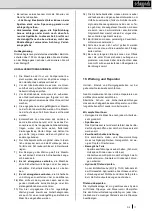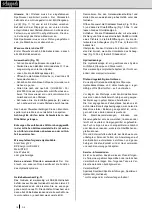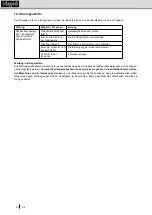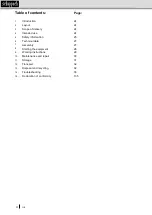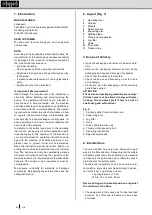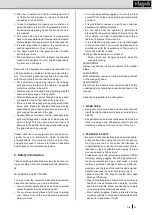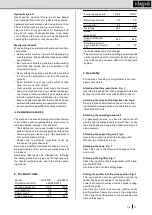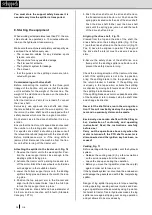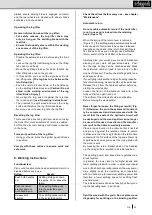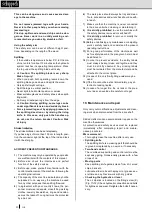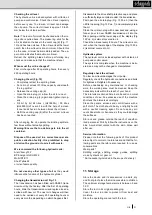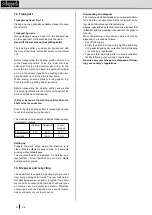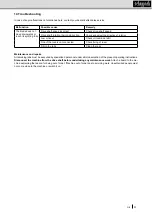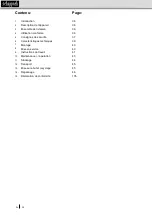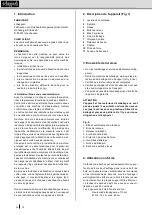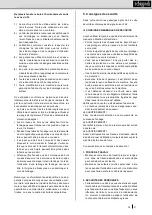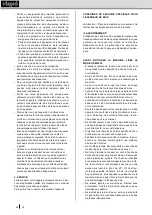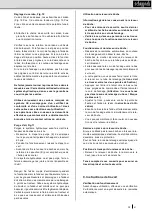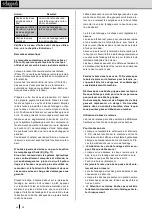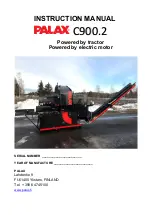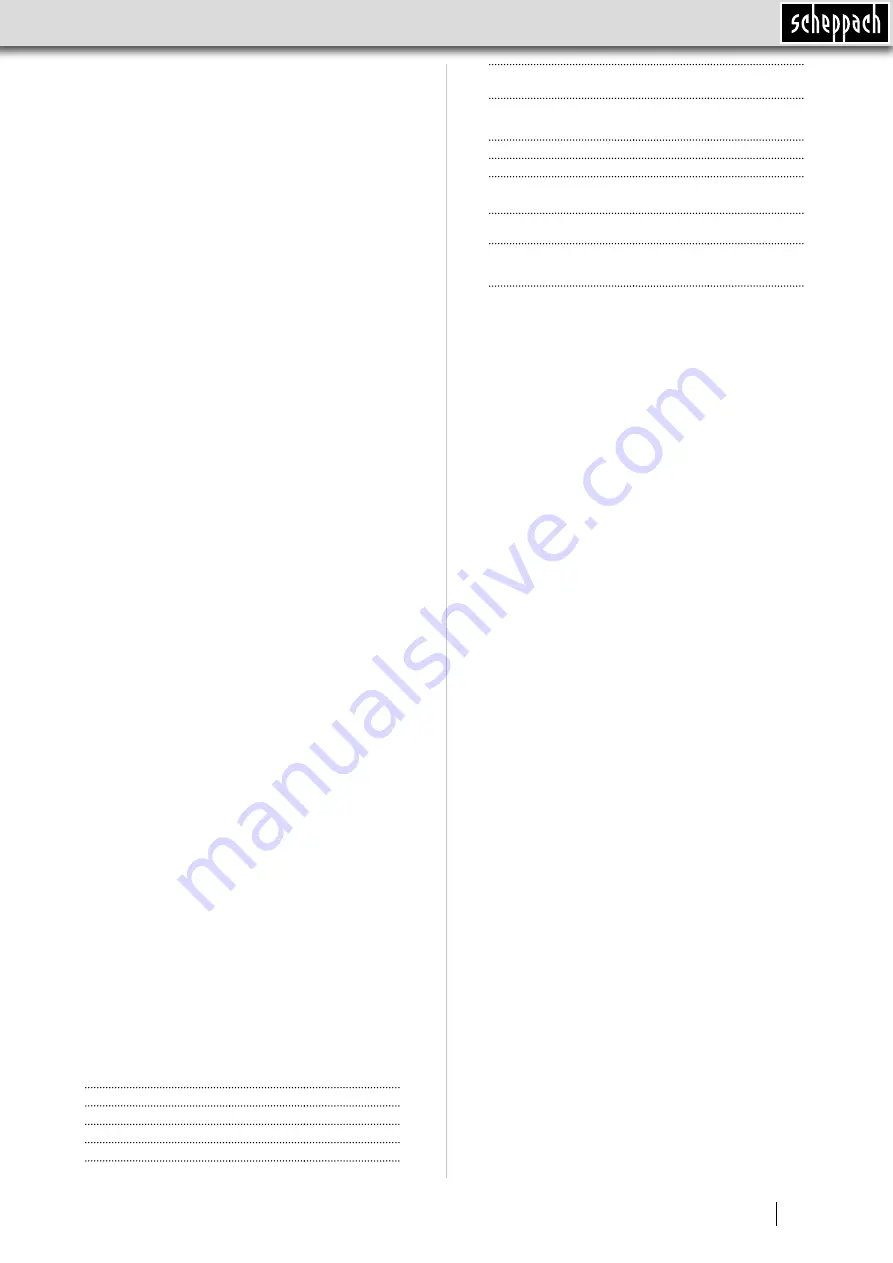
27
GB
Hydraulic system
Never use the machine if there is ever any danger
from hydraulic fluid. Check for leaks in the hydraulic
system every time before you start using the machine.
Check that the machine and your work area are
clean and free of any patches of oil: Hydraulic fluid
may be the cause of danger because it can cause
you to slip and fall, may make your hands slip while
operating the machine or may cause a fire.
Mechanical hazards
Wood splitting is associated with particular mechani
-
cal hazards.
•
Never use this machine if you are not wearing prop
-
er safety gloves, shoes with steel caps and certified
eye protection.
•
Be cautious of splinters generated while working;
avoid stab-like injuries and the possibility of the
machine seizing up.
•
Never attempt to split any trunks which are either
too long or too small and do not fit in the machine
properly.
•
Never attempt to split any trunks which contain
nails, wire or any other objects.
•
Clear up while you work; collections of split wood
and wood chips can make your work area danger
-
ous. Never continue working if your work area is
full to the extent that you could slip, trip or fall over.
•
Keep onlookers well away from the machine and never
permit unauthorized persons to operate the machine.
•
Do not operate the log splitter in its transport position.
m
REMAINING HAZARDS
The machine has been built using modern technology
in accordance with recognized safety rules. Some re
-
maining hazards, however, may still exist.
•
The splitting tool can cause injuries to fingers and
hands if the wood is incorrectly guided or supported.
•
Thrown pieces can lead to injury if the work piece is
not correctly placed or held.
•
Danger due to particular properties of the log
(branches, irregular shape etc)
Even when all safety measures are taken, some re
-
maining hazards which are not yet evident may still
be present.
Remaining hazards can be minimized by following
the safety instructions as well as the instructions in
the chapter Authorized use and in the entire operat
-
ing manual.
6. Technical data
Model
HL1800G
HL2500G
Dimensions D/W/H
890/680/2000
Working height cm
150,5
150,5
Log length cm
110
110
Power max t*
18
25
Piston stroke cm
94,5
94,5
Forward speed cm/s
10/4,8
15/5,5
Return speed cm/s
7,8
7,8
Oil quantity l
24
30
Weight kg
284
357
Drive
Drive shaft
Drive shaft speed
1/min
540
540
Minimum power of
drive machine (tractor)
PS
20
20
Technical datas subject to change!
* The maximum achievable splitting power depends
on the resistance of the material to be split and can,
due to influencing variable, deflect to the hydraulic
system.
7. Assembly
For reasons of packing, your log splitter is not com
-
pletely assembled.
Attaching the three-point bolts, Fig. 3
Insert the threaded bolts in the designated holes and
fix them from the other side with an M22 nut each.
Attaching the drive shaft protective cap, Fig. 4
Place the drive shaft protective cap on the protrud
-
ing threaded receivers at the drive shaft and secure
it with both M10 nuts.
Attaching the operating handles, 5
For packaging reasons, you have to attach the left
and the right operating handle yourself. You can use
the already attached operating handle and Figure 5
as an example.
Attaching the supporting arm, Fig. 6
Secure the supporting arm with a hexagon bolt
M10x40, two washers and a nut.
Attaching the hook, Fig. 7
Attach the hook on the frame with 3 hexagon bolts
and 3 nuts.
Attaching the log lifter, Fig. 7
Attach the log lifter on the fixing bracket with 1 hexa
-
gon bolt M16x100.
Hook the chain onto the splitting blade.
Putting the splitter into the work position, Fig. 8
This operation can only be performed once the log
splitter has been connected to the drive shaft.
Lower both control handles until the cylinder engag
-
es with the guide.
Insert the two L-pins to secure the cylinder on the
kindling splitter. Secure the L-pins in the spring tabs.
Then bring the splitting blade to the top position and
remove the support.
Summary of Contents for 5905501903
Page 2: ...2 Fig 1 1 2 3 4 5 6 7 8 9 10 11 1 7...
Page 3: ...3 1 2 3 4 6 5 8 7 Fig 2 2 M22 A 1 3 2 Fig 3 B 2 M10 2 M22 A 2 4 Fig 4...
Page 6: ...6 Fig 12 max min 1 3 2 Fig 13 1 3 2 Fig 14 Fig 15...
Page 7: ...7 Fig 16 Fig 17 Fig 18 Fig 19...
Page 21: ...21...
Page 47: ...47...
Page 61: ...61...
Page 134: ...134 HL1800G HL2500G...





